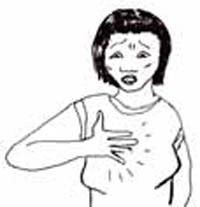Puerperal mastitis

Mastitis is painful inflammation of the breast due to bacterial infection. The bacteria most often causing mastitis, or a more serious breast abscess, are called Staphylococcus aureus. The main source of these bacteria is the suckling baby. Mastitis is more likely to develop during lactation than when the breast is not producing milk. Commonly, it results from milk remaining in the breast for long periods (incomplete emptying), because the baby is not suckling well, or from cracked nipples.
How might cracked nipples be a risk factor for mastitis?
Neglected, resistant, or recurrent infections of the breast can lead to the development of an abscess, a collection of pus within the breast. Pus is a yellowish-white, sticky fluid formed in infected tissue, consisting of bacteria, white blood cells, cellular debris and dying tissue. Women with mastitis often experience pain, fever, chills and muscle aches over the body. The breast will look red, hot and is very painful to touch. When the examination reveals a tender, hard mass with overlying redness, a breast abscess is likely.
If you make a diagnosis of mastitis or breast abscess, give pain relief with paracetamol, supporting the breast with brassieres or anything that can be wrapped around the chest, and refer the woman to a higher health facility and/or nearest hospital for antibiotic treatment.
When you counsel a woman with a breast infection, NEVER advise her to stop feeding the baby from the infected breast. Emptying the breast by letting the baby suckle the milk will help to reduce the problem and the pain. Therefore, encourage breastfeeding unless pus is coming through the nipple. However, breastfeeding is not advised if the cause of breast infection is suspected to be tuberculosis (TB), which is characterised by long-standing evidence of infection with healing (scarring) and new infection in the same breast.